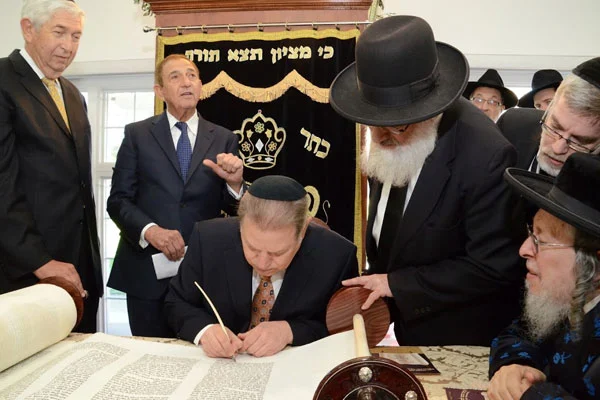
Writing a Sefer Torah
Everyone Must Write a Sefer Torah
“So now, write this song for yourselves, and teach it to the children of Israel; place it in their mouth, so that this song may be for Me a testament with the B’nei Israel.”
Devarim 31:19
From the above verse our Sages derive that every Jew is commanded to write a Torah scroll; a commandment which can be fulfilled by writing a single letter of a complete scroll.
Sefer Torah Projects
Writing or dedicating a new Torah Scroll is a very special decision. Many do so in order to honor the life or memory of a loved one. For Synagogues and Schools, it’s also a major fundraising opportunity.
Undertaking a Sefer Torah project fosters broad community participation, bringing people together through inspirational and educational programming. Bar none, it’s a most memorable and uplifting community building experience. In addition, it provides a wonderful opportunity for one to fulfill the 613th mitzvah of writing a Torah Scroll.
Both on a personal and communal level, ushering a new Sefer Torah into our Synagogue or School, is a most moving and momentous event.

Writing our Holy Script
“And you shall write them”… “With a Perfect Script.”
Guemara Shabbat 130b
The Torah may only be written in Ketav Ashurit meaning “Exalted Script.” This refers to a special calligraphy that has been transmitted from generation to generation for the specific use of writing Sifrei Torah, Tefillin, and Mezuzot.
Writing Traditions
In Judaism, there are three major writing traditions. These influence the shape of the writing font, but not the content of the text. The text of the Torah remains immutable as per our sacred heritage passed down through the ages.
• Bet Yosef Script – Preferred by Ashkenaz Communities
• Ketav Arizal – Preferred by Chassidic & Eastern European Communities
• Sephardic Script – Preferred by Sepharadim and Middle Eastern Jews
Preparing the Parchment
The parchment needs to be processed for the sake of the sanctity of making a Sefer Torah. The best parchment is finished to a soft white velvety texture. As the wet ink dries, it attaches itself to the parchment as roots of a tree do to the soil. Parchments written in this manner can last many hundreds of years.
Using Beautiful Sofer’s Ink
The ink needs to be durable, but not indelible. It was originally made from a mixture of soot, gallnut juice, the sap of a tree, honey or pomegranate juice. Today, most Sofers make ink by boiling crushed gallnuts together with gum arabic and copper sulfate. Carbon is also added at times, allowing the ink to dry to a deep shiny black. The shiny black ink on the white parchment alludes to the Torah being given as "black fire on white fire."
Using a Quill or Reed
It was taught: R. Shimon b. Elazar says: the altar was created to prolong one's years, and the sword, to shorten them. Therefore, the shortener may not be lifted over the lengthener.
Mekhilta D'Rabbi Yishmael
Likewise, a Sefer Torah is intended to bring Life and Peace to the world. Since metal is used to make instruments of war, we abstain from using anything that could be remotely associated with war in the making of our Holy Torah.
Sefardim & Ashkenazim
When writing a Sefer Torah, Sefaradim have traditionally used a reed while Ashkenazim use a quill. The Zohar Hakadosh tells us that the reed was created for writing. With regards to the use of a quill, the important thing is that it comes from a kosher bird such as a turkey or goose.
Preparing to Write the Torah
The Importance of Pure Thoughts
Just as our forefathers cleansed themselves physically and spiritually to receive the Torah at Mount Sinai, the Sofer needs to prepare himself before writing. He does so by immersing in a mikveh and developing pure and proper thoughts. After immersing in the mikveh, the Sofer must begin his writing by saying the following meditation: "I am hereby writing this Scroll of the Torah for the sake of the holiness of the Torah." If the scribe does not have this in mind, the Torah scroll may be very beautiful, but it is not a kosher Sefer Torah. As such, it needs to be entombed.
Having the Proper Intention
Writing Hashem's Holy Name is the most momentous part of writing a Sefer Torah. The Scribe must direct his heart and mind with purity and declare that he is writing each Name for the sake of the sanctity of The Name. If a mistake is done in writing Hashem's name, it cannot be corrected. That particular section of the Torah must be given a dignified burial and entombed.
Throughout all our generations, great care was taken to preserve our Holy Torah exactly as it was given by Moses. Since every Torah must be letter perfect, it must be carefully copied from another scroll or Tikun. Like Moses, the Sofer must repeat every word out loud before writing it down, so as to insure accuracy in copying. This was also the custom among the prophets as seen from when Baruch the scribe wrote down the words of Jeremiah.

